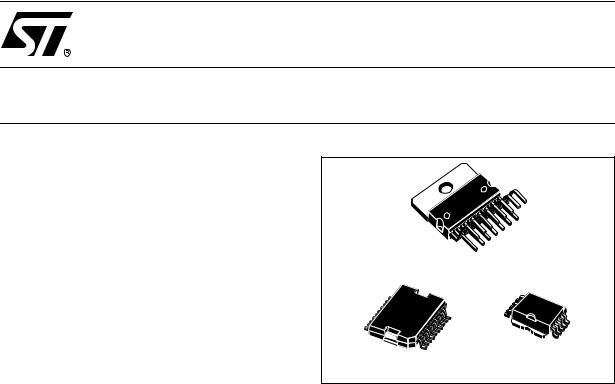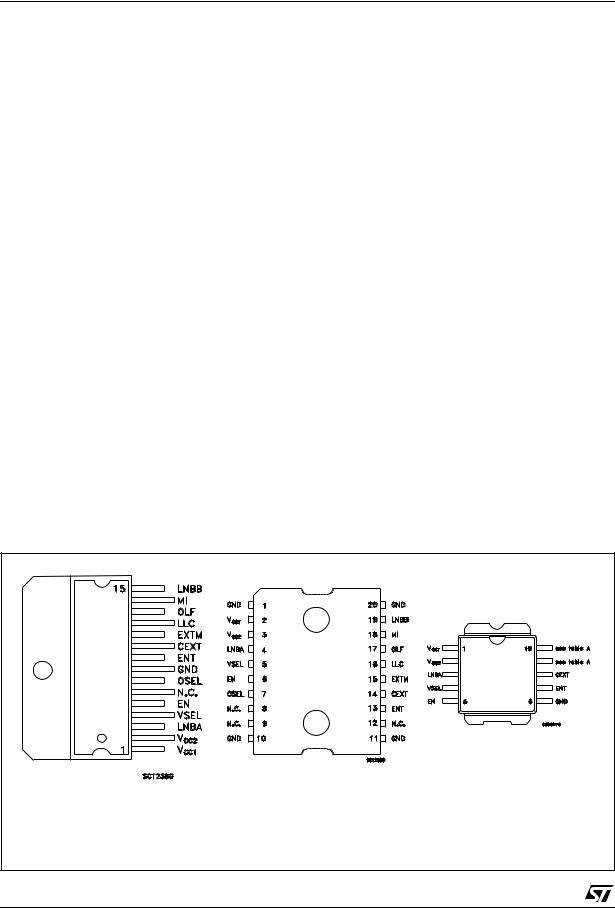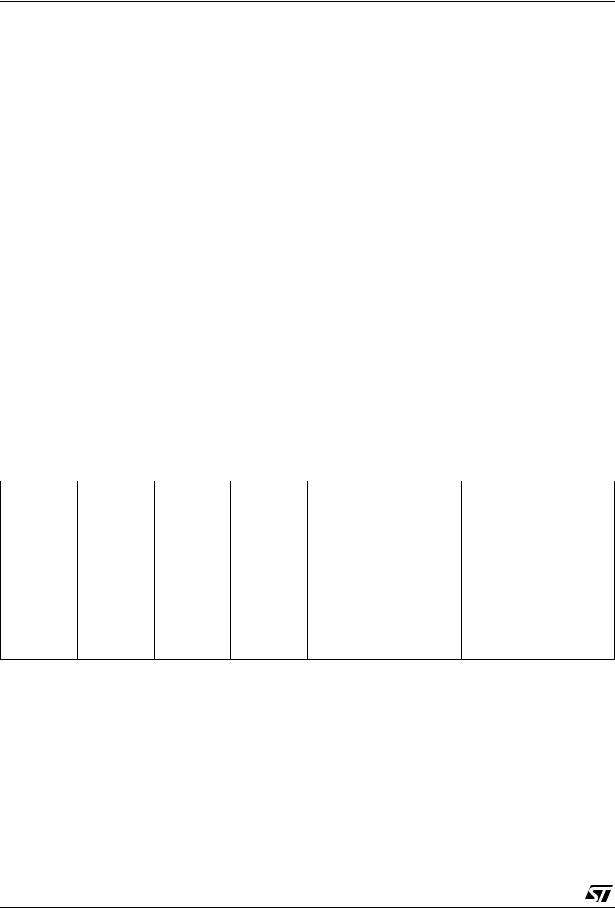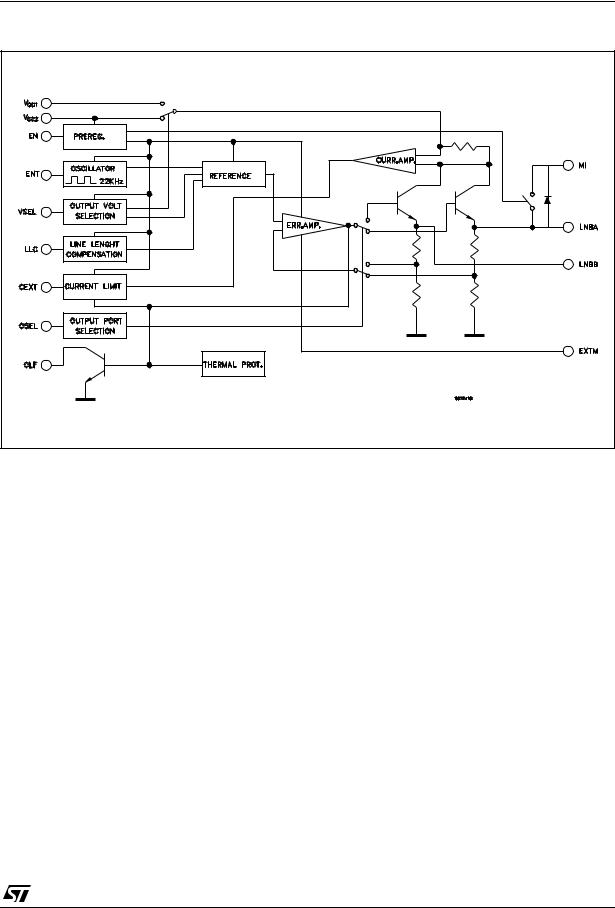SGS Thomson Microelectronics LNBP20PD-TR, LNBP12SP-TR, LNBP11SP-TR, LNBP10SP-TR, LNBP16SP-TR Datasheet
...
LNBP10 SERIES
LNBP20
LNBP SUPPLY AND CONTROL VOLTAGE REGULATOR (PARALLEL INTERFACE)
■COMPLETE INTERFACE FOR TWO LNBs REMOTE SUPPLY AND CONTROL
■LNB SELECTION AND STAND-BY FUNCTION
■BUILT-IN TONE OSCILLATOR FACTORY TRIMMED AT 22KHz
■FAST OSCILLATOR START-UP FACILITATES DiSEqC ENCODING
■TWO SUPPLY INPUTS FOR LOWEST DISSIPATION
■BYPASS FUNCTION FOR SLAVE OPERATION
■LNB SHORT CIRCUIT PROTECTION AND DIAGNOSTIC
■AUXILIARY MODULATION INPUT EXTENDS FLEXIBILITY
■CABLE LENGTH COMPENSATION
■INTERNAL OVER TEMPERATURE PROTECTION
■BACKWARD CURRENT PROTECTION
DESCRIPTION
Intended for analog and digital satellite receivers, the LNBP is a monolithic linear voltage regulator, assembled in Multiwatt-15, PowerSO-20 and PowerSO-10, specifically designed to provide the powering voltages and the interfacing signals to the LNB downconverter situated in the antenna via the coaxial cable. Since most satellite receivers have two antenna ports, the output voltage of the regulator is available at one of two logic-selectable output pins (LNBA, LNBB). When the IC is powered and put in Stand-by (EN pin LOW), both regulator outputs are disabled to allow the antenna downconverters to be supplied/ controlled by others satellite receivers sharing the same coaxial lines. In this occurrence the device will limit at 3 mA (max) the backward current that could flow from LNBA and LNBB output pins to GND.
For slave operation in single dish, dual receiver systems, the bypass function is implemented by an electronic switch between the Master Input pin (MI) and the LNBA pin, thus leaving all LNB powering and control functions to the Master Receiver. This electronic switch is closed when the device is powered and EN pin is LOW.
Multiwatt-15
|
10 |
|
1 |
Power SO-20 |
PowerSO-10 |
The regulator outputs can be logic controlled to be 13 or 18 V (typ.) by mean of the VSEL pin for remote controlling of LNBs. Additionally, it is possible to increment by 1V (typ.) the selected voltage value to compensate the excess voltage drop along the coaxial cable (LLC pin HIGH).
In order to reduce the power dissipation of the device when the lowest output voltage is selected, the regulator has two Supply Input pins VCC1 and VCC2. They must be powered respectively at 16V (min) and 23V (min), and an internal switch automatically will select the suitable supply pin according to the selected output voltage. If adequate heatsink is provided and higher power losses are acceptable, both supply pins can be powered by the same 23V source without affecting any other circuit performance.
The ENT (Tone Enable) pin activates the internal oscillator so that the DC output is modulated by a ±0.3 V, 22KHz (typ.) square wave. This internal oscillator is factory trimmed within a tolerance of ±2KHz, thus no further adjustments neither external components are required.
A burst coding of the 22KHz tone can be accomplished thanks to the fast response of the ENT input and the prompt oscillator start-up. This helps designers who want to implement the DiSEqC protocols (*).
In order to improve design flexibility and to allow implementation of newcoming LNB remote control standards, an analogic modulation
June 2003 |
1/20 |

LNBP10 SERIES - LNBP20
input pin is available (EXTM). An appropriate DC blocking capacitor must be used to couple the modulating signal source to the EXTM pin. When external modulation is not used, the relevant pin can be left open.
Two pins are dedicated to the overcurrent protection/monitoring: CEXT and OLF. The overcurrent protection circuit works dynamically: as soon as an overload is detected in either LNB output, the output is shut-down for a time toff determined by the capacitor connected between CEXT and GND. Simultaneously the OLF pin, that is an open collector diagnostic output flag, from HIGH IMPEDANCE state goes LOW.
After the time has elapsed, the output is resumed for a time ton=1/15toff (typ.) and OLF goes in HIGH
IMPEDANCE. If the overload is still present, the protection circuit will cycle again through toff and ton until the overload is removed. Typical ton+toff value is 1200ms when a 4.7μF external capacitor is used.
This dynamic operation can greatly reduce the power dissipation in short circuit condition, still ensuring excellent power-on start up even with highly capacitive loads on LNB outputs.
The device is packaged in Multiwatt15 for thru-holes mounting and in PowerSO-20 for surface mounting. When a limited functionality in a smaller package matches design needs, a range of cost-effective PowerSO-10 solutions is also offered. All versions have built-in thermal protection against overheating damage.
(*): External components are needed to comply to level 2.x and above (bidirectional) DiSEqC bus hardware requirements. DiSEqC is a trademark or EUTELSAT.
ORDERING CODES
TYPE |
Multiwatt-15 |
PowerSO-20 |
PowerSO-10 |
|
|
|
|
LNBP10 |
|
|
LNBP10SP-TR (*) |
|
|
|
|
LNBP11 |
|
|
LNBP11SP-TR (*) |
|
|
|
|
LNBP12 |
|
|
LNBP12SP-TR (*) |
|
|
|
|
LNBP13 |
|
|
LNBP13SP-TR (*) |
|
|
|
|
LNBP14 |
|
|
LNBP14SP-TR (*) |
|
|
|
|
LNBP15 |
|
|
LNBP15SP-TR (*) |
LNBP16 |
|
|
LNBP16SP-TR (*) |
|
|
|
|
LNBP20 |
LNBP20CR |
LNBP20PD-TR |
|
|
|
|
|
(*) Available on request
PIN CONFIGUARATION (top view)
Multiwatt-15 |
PowerSo-20 |
PowerSO-10 |
2/20 |
|
|

LNBP10 SERIES - LNBP20
TABLE A: PIN CONFIGURATIONS
SYMBOL |
NAME |
FUNCTION |
|
PIN NUMBER vs SALES TYPE (LNBP) |
|
|||||||
|
|
|
|
|
|
|
|
|
||||
20CR |
20PD |
10SP |
11SP |
12SP |
13SP |
14SP |
15SP |
16SP |
||||
|
|
|
||||||||||
|
|
|
|
|
|
|
|
|
|
|
|
|
VCC1 |
Supply Input 1 |
15V to 25V supply. It is |
1 |
2 |
1 |
1 |
1 |
|
1 |
1 |
1 |
|
|
|
automatically selected |
|
|
|
|
|
|
|
|
|
|
|
|
when VOUT= 13 or 14V |
|
|
|
|
|
|
|
|
|
|
VCC2 |
Supply Input 2 |
22V to 25V supply. It is |
2 |
3 |
2 |
2 |
2 |
2 |
2 |
2 |
2 |
|
|
|
automatically selected |
|
|
|
|
|
|
|
|
|
|
|
|
when VOUT= 18 or 19V |
|
|
|
|
|
|
|
|
|
|
LNBA |
Output Port |
See truth table voltage |
3 |
4 |
3 |
3 |
3 |
3 |
3 |
3 |
3 |
|
|
|
and port selection. In |
|
|
|
|
|
|
|
|
|
|
|
|
stand-by mode this port |
|
|
|
|
|
|
|
|
|
|
|
|
is powered by the MI pin |
|
|
|
|
|
|
|
|
|
|
|
|
via the internal Bypass |
|
|
|
|
|
|
|
|
|
|
|
|
Switch |
|
|
|
|
|
|
|
|
|
|
|
|
|
|
|
|
|
|
|
|
|
|
|
VSEL |
Output Voltage |
Logic control input: see |
4 |
5 |
4 |
4 |
4 |
4 |
4 |
4 |
4 |
|
|
Selection:13 or |
truth table |
|
|
|
|
|
|
|
|
|
|
|
18V (typ) |
|
|
|
|
|
|
|
|
|
|
|
|
|
|
|
|
|
|
|
|
|
|
|
|
EN |
Port Enable |
Logic control input: see |
5 |
6 |
5 |
5 |
5 |
5 |
5 |
5 |
5 |
|
|
|
truth table |
|
|
|
|
|
|
|
|
|
|
|
|
|
|
|
|
|
|
|
|
|
|
|
OSEL |
Port Selection |
Logic control input: see |
7 |
7 |
9 |
NA |
NA |
NA |
NA |
NA |
NA |
|
|
|
truth table |
|
|
|
|
|
|
|
|
|
|
|
|
|
|
|
|
|
|
|
|
|
|
|
GND |
Ground |
Circuit Ground. It is |
8 |
1 |
6 |
6 |
|
6 |
6 |
6 |
6 |
|
|
|
internally connected to |
|
10 |
|
|
|
|
|
|
|
|
|
|
the die frame |
|
11 |
|
|
|
|
|
|
|
|
|
|
|
|
20 |
|
|
|
|
|
|
|
|
ENT |
22KHz Tone |
Logic control input: see |
9 |
13 |
7 |
7 |
7 |
7 |
7 |
7 |
7 |
|
|
Enable |
truth table |
|
|
|
|
|
|
|
|
|
|
|
|
|
|
|
|
|
|
|
|
|
|
|
CEXT |
External |
Timing Capacitor used |
10 |
14 |
8 |
8 |
8 |
8 |
8 |
8 |
8 |
|
|
Capacitor |
by the Dynamic |
|
|
|
|
|
|
|
|
|
|
|
|
Overload protection. |
|
|
|
|
|
|
|
|
|
|
|
|
Typical application is |
|
|
|
|
|
|
|
|
|
|
|
|
4.7μF for a 1200ms |
|
|
|
|
|
|
|
|
|
|
|
|
cycle |
|
|
|
|
|
|
|
|
|
|
|
|
|
|
|
|
|
|
|
|
|
|
|
EXTM |
External |
External Modulation |
11 |
15 |
NA |
NA |
NA |
9 |
NA |
9 |
9 |
|
|
Modulator |
Input. Needs DC |
|
|
|
|
|
|
|
|
|
|
|
|
decoupling to the AC |
|
|
|
|
|
|
|
|
|
|
|
|
source. if not used, can |
|
|
|
|
|
|
|
|
|
|
|
|
be left open. |
|
|
|
|
|
|
|
|
|
|
|
|
|
|
|
|
|
|
|
|
|
|
|
LLC |
Line Length |
Logic control input: see |
12 |
16 |
NA |
NA |
9 |
NA |
9 |
NA |
10 |
|
|
Compens. |
truth table |
|
|
|
|
|
|
|
|
|
|
|
(1V typ) |
|
|
|
|
|
|
|
|
|
|
|
|
|
|
|
|
|
|
|
|
|
|
|
|
OLF |
Over Load |
Logic output (open |
13 |
17 |
NA |
9 |
NA |
NA |
10 |
10 |
NA |
|
|
Flag |
collector). Normally in |
|
|
|
|
|
|
|
|
|
|
|
|
HIGH IMPEDANCE, |
|
|
|
|
|
|
|
|
|
|
|
|
goes LOW when current |
|
|
|
|
|
|
|
|
|
|
|
|
or thermal overload |
|
|
|
|
|
|
|
|
|
|
|
|
occurs |
|
|
|
|
|
|
|
|
|
|
|
|
|
|
|
|
|
|
|
|
|
|
|
MI |
Master Input |
In stand-by mode, the |
14 |
18 |
NA |
10 |
10 |
10 |
NA |
NA |
NA |
|
|
|
voltage on MI is routed |
|
|
|
|
|
|
|
|
|
|
|
|
to LNBA pin. Can be left |
|
|
|
|
|
|
|
|
|
|
|
|
open if bypass function |
|
|
|
|
|
|
|
|
|
|
|
|
is not needed |
|
|
|
|
|
|
|
|
|
|
|
|
|
|
|
|
|
|
|
|
|
|
|
LNBB |
Output Port |
See truth tables for |
15 |
19 |
10 |
NA |
NA |
NA |
NA |
NA |
NA |
|
|
|
voltage and port |
|
|
|
|
|
|
|
|
|
|
|
|
selection |
|
|
|
|
|
|
|
|
|
|
|
|
|
|
|
|
|
|
|
|
|
|
|
NOTE: the limited pin availability of the PowerSO-10 package leads to drop some functions. |
|
|
|
|
|
|||||||
|
|
|
|
|
|
|
|
|
|
|
3/20 |
|
|
|
|
|
|
|
|
|
|
|
|
|
|

LNBP10 SERIES - LNBP20
ABSOLUTE MAXIMUM RATINGS
Symbol |
Parameter² |
Value |
Unit |
|
|
|
|
VI |
DC Input Voltage (VCC1, VCC2, MI) |
28 |
V |
IO |
Output Current (LNBA, LNBB) |
Internally Limited |
mA |
VI |
Logic Input Voltage (ENT, EN OSEL, VSEL, LLC) |
-0.5 to 7 |
V |
ISW |
Bypass Switch Current |
900 |
mA |
PD |
Power Dissipation at Tcase < 85°C |
14 |
W |
Tstg |
Storage Temperature Range |
-40 to +150 |
°C |
Top |
Operating Junction Temperature Range |
-40 to +125 |
°C |
Absolute Maximum Ratings are those values beyond which damage to the device may occur. Functional operation under these condition is not implied.
THERMAL DATA
Symbol |
Parameter |
Value |
Unit |
|
|
|
|
Rthj-case |
Thermal Resistance Junction-case |
2 |
°C/W |
LOGIC CONTROLS TRUTH TABLE
CONTROL I/O |
PIN NAME |
L |
H |
||
|
|
|
|
|
|
|
OUT |
|
OLF |
IOUT > IOMAX or Tj > 150°C |
I OUT < IOMAX |
|
IN |
|
ENT |
22KHz tone OFF |
22KHz tone ON |
|
|
|
|
|
|
|
IN |
|
EN |
See Table Below |
See Table Below |
|
IN |
|
OSEL |
See Table Below |
See Table Below |
|
|
|
|
|
|
|
IN |
|
VSEL |
See Table Below |
See Table Below |
|
IN |
|
LLC |
See Table Below |
See Table Below |
|
|
|
|
|
|
|
|
|
|
|
|
EN |
OSEL |
VSEL |
LLCO |
VLNBA |
VLNBB |
L |
X |
X |
X |
VMI - 0.4V (typ.) |
Disabled |
H |
L |
L |
L |
13V (typ.) |
Disabled |
|
|
|
|
|
|
H |
L |
H |
L |
18V (typ.) |
Disabled |
|
|
|
|
|
|
H |
L |
L |
H |
14V (typ.) |
Disabled |
|
|
|
|
|
|
H |
L |
H |
H |
19V (typ.) |
Disabled |
H |
H |
L |
L |
Disabled |
13V (typ.) |
|
|
|
|
|
|
H |
H |
H |
L |
Disabled |
18V (typ.) |
|
|
|
|
|
|
H |
H |
L |
H |
Disabled |
14V (typ.) |
|
|
|
|
|
|
H |
H |
H |
H |
Disabled |
19V (typ.) |
NOTE: All logic input pins have internal pull-down resistor (typ. = 250KΩ)
4/20

LNBP10 SERIES - LNBP20
BLOCK DIAGRAM
5/20

LNBP10 SERIES - LNBP20
ELECTRICAL CHARACTERISTICS FOR LNBP SERIES (TJ = 0 to 85°C, CI = 0.22μF, CO =0.1μF, EN=H, ENT=L, LLC=L, VIN1=16V, VIN2=23V IOUT=50mA, unless otherwise specified.)
Symbol |
Parameter |
|
Test Conditions |
|
Min. |
Typ. |
Max. |
Unit |
||
|
|
|
|
|
|
|
|
|||
VIN1 |
VCC1 Supply Voltage |
IO = 500 mA ENT=H, VSEL=L, |
LLC=L |
15 |
|
25 |
V |
|||
|
|
IO = 500 mA ENT=H, VSEL=L, |
LLC=H |
16 |
|
25 |
V |
|||
VIN2 |
VCC2 Supply Voltage |
IO = 500 mA ENT=H, VSEL=L, |
LLC=L |
22 |
|
25 |
V |
|||
|
|
IO = 500 mA VSEL=L, |
LLC=H |
|
23 |
|
25 |
V |
||
VO1 |
Output Voltage |
IO = 500 mA VSEL=L, |
LLC=L |
|
17.3 |
18 |
18.7 |
V |
||
|
|
IO = 500 mA ENT=H, VSEL=L, |
LLC=H |
|
19 |
|
V |
|||
VO2 |
Output Voltage |
IO = 500 mA VSEL=L, |
LLC=L |
|
12.5 |
13 |
13.5 |
V |
||
|
|
IO = 500 mA ENT=H, VSEL=L, |
LLC=H |
|
14 |
|
V |
|||
VO |
Line Regulation |
VIN1=15 to 18V |
VOUT=13V |
|
|
4 |
40 |
mV |
||
|
|
VIN2=22 to 25V |
VOUT=18V |
|
|
4 |
40 |
mV |
||
VO |
Load Regulation |
VIN1=VIN2=22V |
VOUT=13 or 18V |
|
80 |
180 |
mV |
|||
|
|
IO = 50 to 500mA |
|
|
|
|
|
|
|
|
SVR |
Supply Voltage Rejection |
VIN1 = VIN2 = 23 ± 0.5Vac fac = 120 Hz, |
|
45 |
|
dB |
||||
IMAX |
Output Current Limiting |
|
|
|
|
|
500 |
650 |
800 |
mA |
tOFF |
Dynamic Overload |
Output Shorted |
CEXT =4.7μF |
|
|
1100 |
|
ms |
||
|
protection OFF Time |
|
|
|
|
|
|
|
|
|
tON |
Dynamic Overload |
Output Shorted |
CEXT =4.7μF |
|
|
tOFF/15 |
|
ms |
||
|
protection ON Time |
|
|
|
|
|
|
|
|
|
fTONE |
Tone Frequency |
ENT=H |
|
|
|
|
20 |
22 |
24 |
KHz |
ATONE |
Tone Amplitude |
ENT=H |
|
|
|
|
0.55 |
0.72 |
0.9 |
Vpp |
DTONE |
Tone Duty Cycle |
ENT=H |
|
|
|
|
40 |
50 |
60 |
% |
tr, tf |
Tone Rise and Fall Time |
ENT=H |
|
|
|
|
5 |
10 |
15 |
μs |
GEXTM |
External Modulation Gain |
VOUT/ VEXTM, |
f = 10Hz to 40KHz |
|
5 |
|
|
|||
VEXTM |
External Modulation Input |
AC Coupling |
|
|
|
|
|
400 |
mVpp |
|
|
Voltage |
|
|
|
|
|
|
|
|
|
ZEXTM |
External Modulation |
f = 10Hz to 40KHz |
|
|
|
400 |
|
Ω |
||
|
Impedance |
|
|
|
|
|
|
|
|
|
VSW |
Bypass Switch Voltage |
EN=L, |
ISW=300mA, |
VCC2-VMI=4V |
|
0.35 |
0.6 |
V |
||
|
Drop (MI to LNBA) |
|
|
|
|
|
|
|
|
|
VOL |
Overload Flag Pin Logic |
IOL=8mA |
|
|
|
|
|
0.28 |
0.5 |
V |
|
LOW |
|
|
|
|
|
|
|
|
|
IOZ |
Overload Flag Pin OFF |
VOH = 6V |
|
|
|
|
|
|
10 |
μA |
|
State Leakage Current |
|
|
|
|
|
|
|
|
|
VIL |
Control Input Pin Logic |
|
|
|
|
|
|
|
0.8 |
V |
|
LOW |
|
|
|
|
|
|
|
|
|
VIH |
Control Input Pin Logic |
|
|
|
|
|
2.5 |
|
|
V |
|
HIGH |
|
|
|
|
|
|
|
|
|
IIH |
Control Pins Input Current |
VIH = 5V |
|
|
|
|
|
20 |
|
μA |
ICC |
Supply Current |
Output Disabled (EN=L) |
|
|
|
0.3 |
1 |
mA |
||
|
|
ENT=H, |
IOUT=500mA |
|
|
3.1 |
6 |
mA |
||
IOBK |
Output Backward Current |
EN=L |
VLNBA = VLNBB = 18V |
|
0.2 |
3 |
mA |
|||
|
|
VIN1 = VIN2 = 22V or floating |
|
|
|
|
|
|||
TSHDN |
Temperature Shutdown |
|
|
|
|
|
|
150 |
|
°C |
|
Threshold |
|
|
|
|
|
|
|
|
|
6/20
